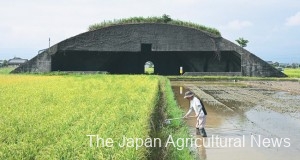| KOCHI, Aug. 16 – In Maehama, Nankoku City, Kochi Prefecture, there still are reinforced concrete bomb shelters, called entaigo in Japanese, built in wartime to protect battle plains. The gray ferroconcrete structures were sitting in green ripe rice fields.
There are seven entaigo remaining in this area, and the biggest one, the No.4 Entaigo, measures 44 meters in width, 23 meters in depth, and 8.5 meters in height. The dome-shaped structure built to house a two-engine large-sized plane is still partially covered with camouflage soil and grasses. After the war, local farmers started using it to keep agricultural machinery and as a place to work in winter. Shinji Fujimoto is a 92-year-old chairman of a local association that protects and keeps entaigo buildings as cultural assets. He was one of the constructors of the entaigo. Fujimoto joined the army in his second year of junior high school. He remembers that he was made to practice suicide bombings on a nearby beach to prevent the enemy’s landing. “Back then, we were desperate to win,” he recalls. Tateo Nomura is a 91-year-old farmer who began farming near the entaigo before the war. After the war, he cleared the desolate land by hand. “I want to pass it on to the next generations,” said Nomura. |


